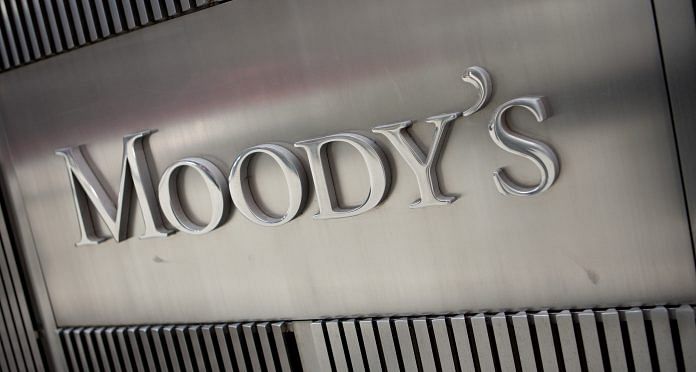New Delhi: Moody’s Investors Service on Tuesday said economic growth projections made by Finance Minister Nirmala Sitharaman in her Budget for 2020-21 appear ambitious given the structural and cyclical challenges facing the Indian economy.
The budget expects nominal GDP growth of 10 per cent in 2020-21, followed by 12.6 per cent and 12.8 per cent in FY2022 and 2023. But, Moody’s saw GDP growth rising to around 8.7 per cent in the next financial year beginning April 1 from about 7.5 per cent in the current fiscal.
Stating that growth outlook will remain weak, it has put real GDP growth during the current fiscal ending March 31 at 4.9 per cent, slightly below the government’s forecast of 5 per cent. For the next fiscal, it estimated real GDP growth of 5.5 per cent, lower than 6-6.5 per cent projected by the government’s Economic Survey.
“Growth has remained relatively weak as a prolonged deleveraging cycle and ongoing stress among non-banking financial institutions (NBFIs), which has constrained the financial system’s overall provision of credit, weigh on consumption and investment,” it said in a detailed commentary on the Budget.
For the next 2020-21 fiscal, it lowered real GDP growth forecasts to 5.5 per cent from 6.3 per cent previous estimate. And for the following fiscal, it put the real GDP growth at 6 per cent from 6.7 per cent projected earlier.
“The significant slowdown in financial sector credit growth from NBFI liquidity constraints and asset quality issues among public sector banks has exacerbated prolonged weakness in private investment and a material decline in consumption, due in part to financial stress among rural households and weak job creation,” Moody’s said.
The nominal GDP growth, it said, has also declined significantly. Following 11.2 per cent expansion in 2018-19, the government had forecast 12 per cent nominal GDP growth in its July 2019 budget for the current fiscal.
However, according to the government’s first advance estimate of GDP last month, nominal GDP growth is likely fell to a much lower rate of around 7.5 per cent for full 2019-20.
“These forecasts (made the Budget) appear ambitious given the combination of structural and cyclical challenges that the Indian economy faces,” it said.
Moody’s said the government will face challenges in achieving its deficit target for the fiscal year ending March 2021, amid persistent structural and cyclical headwinds to growth.
Sitharaman is targeting narrowing of fiscal deficit to 3.5 per cent of the GDP in the next financial year from 3.8 per cent in the current – wider than the 3.3 per cent that the government previously predicted.
“While the latest budget targets a narrower deficit, prolonged weakness in nominal GDP growth in India, combined with lower revenue collections, has dampened the outlook for fiscal consolidation, raising the risk that the debt burden may not stabilize,” says Gene Fang, a Moody’s Associate Managing Director.
“The debt burden is sensitive to nominal GDP growth, which we expect will remain lower on average than in the past. In light of India’s weak fiscal health compared with its rating peers, any slippage in debt reduction will be credit negative.”
Also read: Burden of rescuing Indian economy back on RBI after Modi govt’s disappointing Budget
The slippage in meeting fiscal deficit targets “reflects significantly weaker economic growth and revenue collection than the authorities forecast in July 2019,” Moody’s said. “Any material strengthening in India’s public finances is unlikely in the near term as obstacles to growth persist.”
It went on to state that prolonged weakness in nominal GDP growth and lower revenue collection raise the risk that the government debt burden does not stabilize.
The rating agency said while the five-fold rise in deposit insurance limit to Rs 5 lakh is credit positive for banks, the Budget seeking dividends from state-owned companies that are higher than the tax-saving they got from the abolition of the dividend distribution tax (DDT) was credit negative for oil and gas companies.
But, the rise in public infrastructure spending and tax exemptions for sovereign wealth funds was credit positive for the infrastructure sector, it said, adding quicker debt recovery and additional interest deduction on home loans was credit positive for Indian securitization transactions.
Moody’s said even before the significant slowing in economic expansion in 2019, nominal GDP growth had averaged about 11 per cent over the five years from 2014 to 2018.
“We expect the economy to rebound at a more modest pace, with nominal GDP growth rising to around 8.7 per cent in fiscal 2020 (2020-21) and 10.5 per cent in fiscal 2021 (2021-22), from about 7.5 per cent in fiscal 2019 (2019-20),” it said.
India’s historically high rate of nominal GDP growth was an important driver of a declining debt burden in the past, from above 80 per cent of GDP in the early 2000s to about 67 per cent in 2010.
“Given India’s fiscal constraints, we believe that durable fiscal consolidation is only likely to occur if nominal GDP growth rebounds to at least 11 per cent over the medium term,” it added.
Also read: Why Narendra Modi has taken the big and the bang out of the Budget




All projections mentioned in budget is ambitious. But what’s the ground reality. They mention sooo many schemes in budget. Very few has been implemented. Due to job losses, dwindling economy, inflation, Bank losses, people don’t have money to spend how the economy will grow. Add to this religious politics/divide and hatred. How the nation will grow??
That is true. Ambitious GDP . Why take a Phoren guru to call this buff? Almost all well known Indian gurus had written off before the Budget was released. Fudging will fool people?